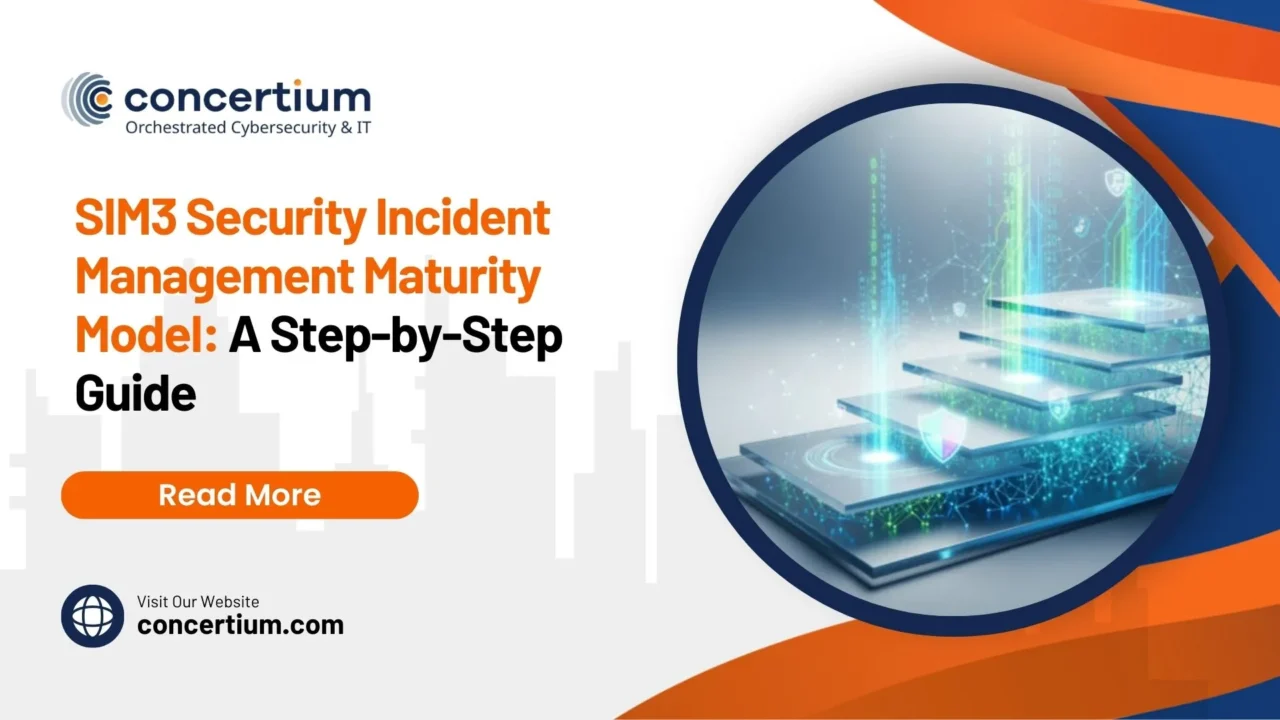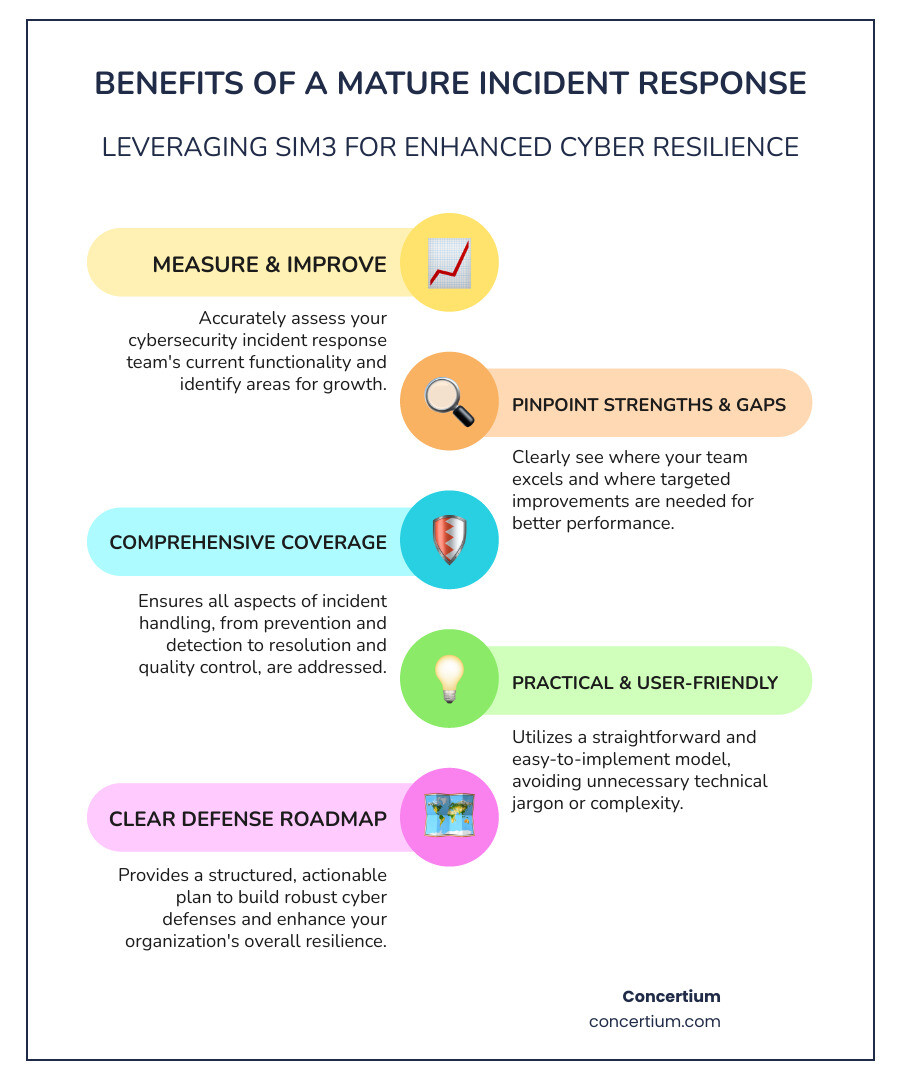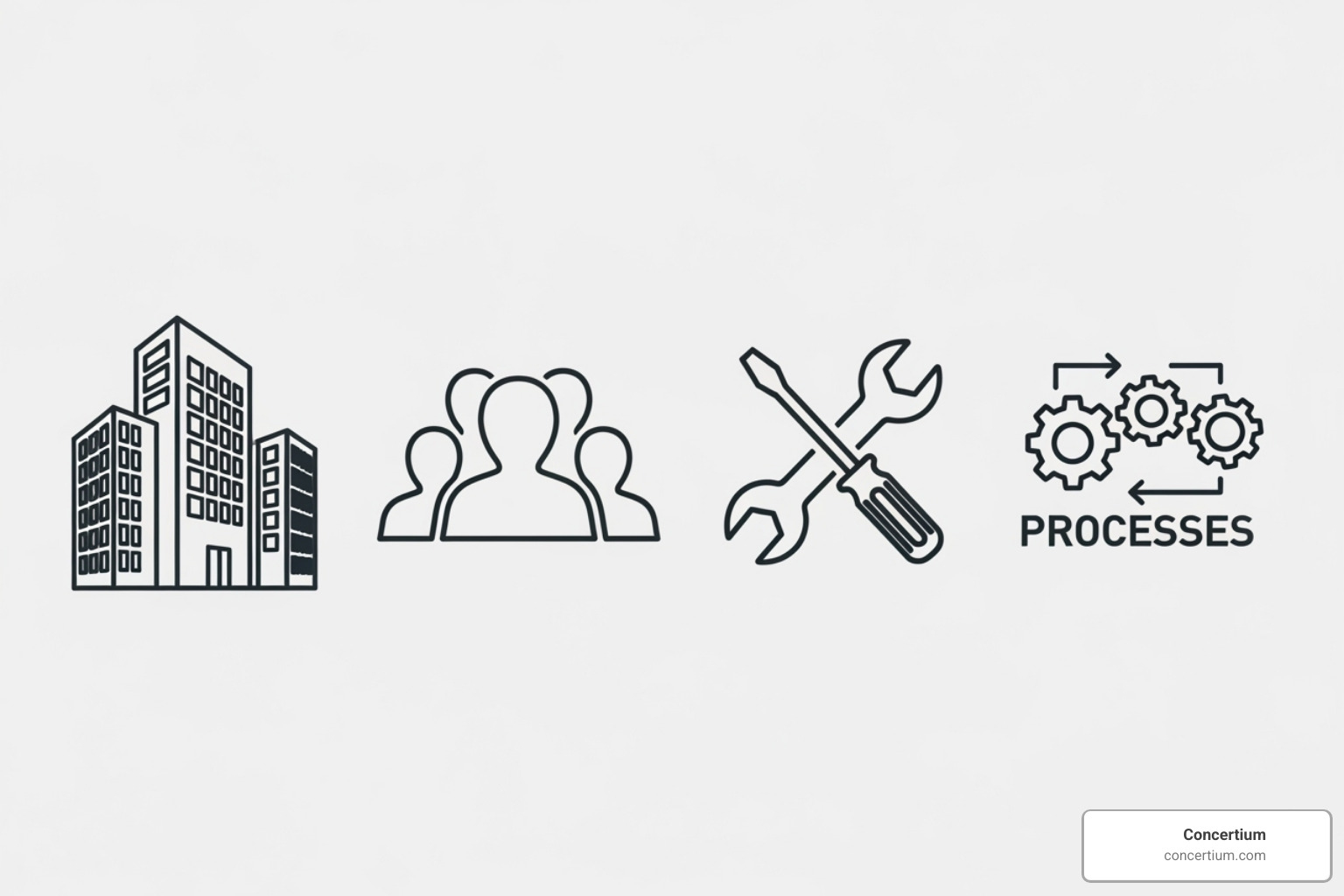The SIM3 Security Incident Management Maturity Model is a framework that helps organizations measure and improve their cybersecurity incident response team functions. Created by Don Stikvoort in 2008 and managed by the Open CSIRT Foundation, SIM3 evaluates teams across 44 parameters in four key areas: Organization, Human resources, Tools, and Processes.
Quick SIM3 Overview:
- Purpose: Measure and improve cybersecurity incident response capabilities
- Categories: 4 pillars (Organization, Human, Tools, Processes)
- Parameters: 44 specific areas to evaluate
- Maturity Levels: 0-4 scale (Not available to Explicit audited)
- Global Use: Adopted by ENISA, FIRST, and over 300 CSIRTs worldwide
SIM3 acts as a report card for your incident response team, showing strengths and areas for improvement. The model covers the full lifecycle: prevention, detection, resolution, and quality control.
Unlike complex ISO standards, SIM3 is practical and easy to use. That’s why organizations from the EU CSIRTs Network to the Nippon CSIRT Association use it to improve their cybersecurity capabilities.
The framework helps answer critical questions: Can your team handle a major cyber incident? Do you have the right people, tools, and processes in place? How do you stack up against industry best practices?
For business owners, SIM3 provides a clear roadmap to build better cyber defenses without getting lost in technical jargon.
Key sim3 security incident management maturity model vocabulary:
Understanding the Core Components of the SIM3 Security Incident Management Maturity Model
While the SIM3 Security Incident Management Maturity Model might seem complex, it’s a straightforward tool for assessing and improving your incident response team.
Think of SIM3 as a health check for your cybersecurity team. It assesses capabilities across four main pillars and assigns one of five maturity levels to help you understand where you stand.
Instead of simply asking “Do you have an incident response team?”, SIM3 measures how well the team functions. This focus on maturity measurement and continuous improvement helps organizations build stronger cyber defenses over time.
SIM3 takes a holistic assessment approach, recognizing that a weakness in one area can impact the entire response capability. For organizations serious about improving their cybersecurity posture, understanding this framework is crucial for building a comprehensive Incident Management Maturity Model that works in the real world.
The Four Foundational Pillars
The SIM3 Security Incident Management Maturity Model is built on four pillars, each representing a critical aspect of effective incident response.
Organizational (O) parameters form the backbone of your response capability. This pillar defines the team’s foundation: its mandate, constituency, authority, responsibilities, and services. A clear organizational structure is essential for success.
Human (H) parameters recognize that people are your most valuable asset. This pillar focuses on staffing levels, team resilience to absences, member skills, and ongoing training programs.
Tools (T) parameters focus on the technology that amplifies your team’s capabilities. This pillar covers the technology used for incident tracking, communication, detection, and resolution.
Process (P) parameters ensure everything runs smoothly. This pillar ensures consistency through defined procedures for incident handling, information classification, quality management, and intelligence gathering.
The magic happens when these four pillars work together. This interconnectedness is why successful incident response requires attention to all four areas.
The Five Maturity Levels Explained
Each parameter in the SIM3 Security Incident Management Maturity Model is scored on a 0-4 scale, telling a story about your capability’s maturity:
Level 0: Not available means the capability does not exist.
Level 1: Implicit means capabilities are informal and undocumented, relying on individual knowledge. This can be fragile.
Level 2: Explicit internal means procedures are documented for internal team use but may lack formal approval or integration with broader policies.
Level 3: Explicit formalised means capabilities are formally documented, approved by management, and integrated into the organization’s framework.
Level 4: Explicit audited is the highest level. Capabilities are formalized, regularly audited, and continuously improved through formal governance.
Higher isn’t always better for every parameter; the optimal level depends on your team’s mission, size, and threats. Evidence requirements become more stringent as you move up the levels, requiring documentation and proof that your capabilities work as intended. This progression creates a clear roadmap for improvement.
The Four Pillars of SIM3: A Detailed Breakdown
Let’s dive deeper into the four pillars of the SIM3 Security Incident Management Maturity Model. Understanding the specific parameters within each category is crucial for a thorough assessment and for crafting a targeted improvement plan.
As we explore these, our goal at Concertium is to help organizations achieve robust Compliance and Risk Management through mature cybersecurity practices.
Organizational (O) Parameters
The Organizational pillar sets the stage for the CSIRT’s operations. Key parameters include:
- Mandate (O-1): The formal authorization for the CSIRT’s existence and operations.
- Constituency (O-2): The specific group or entity the CSIRT is responsible for protecting.
- Authority (O-3): What the CSIRT is permitted to do to fulfill its mandate (e.g., advise, enforce).
- Responsibility (O-4): What the CSIRT is expected to do for its constituency.
- Service Description (O-5): A detailed list of services offered by the CSIRT.
- Security Policy (O-11): The information security policy governing the CSIRT’s operations.
National CSIRTs often require higher maturity levels in these parameters due to their critical role in national security.
Human (H) Parameters
The Human pillar ensures your team has the right people with the right skills.
- Staffing (H-1): The number of personnel available to handle the workload.
- Personnel Resilience (H-2): The team’s ability to operate effectively during staff absences.
- Skillset (H-3): The technical and soft skills of the team members.
- Training (H-4): Ongoing training programs to maintain and develop skills.
- Awareness (H-5): The security awareness level of the broader organization.
Tools (T) Parameters
The Tools pillar assesses the technological backbone of your incident management.
- Incident Tracking (T-1): A system to log, track, and manage incidents (e.g., RTIR, AIRT, OTRS).
- Communication (T-5): Reliable and secure channels for internal and external communication.
- Incident Detection (T-9): Tools used to identify incidents, such as IDS, SIEM, and EDR, often improved with AI.
- Incident Resolution (T-10): Tools used to resolve incidents, including forensic and malware analysis platforms.
Process (P) Parameters
The Process pillar defines how the CSIRT operates, ensuring consistency.
- Incident Handling (P-1): Defined procedures for handling incidents from triage to post-incident review.
- Information Classification (P-3): The process for classifying and handling sensitive information.
- Quality Management (P-8): Processes to ensure service quality and identify improvements, often through audits and feedback.
- Information Sources (P-10): How the team gathers and manages information from sources like threat intelligence feeds.
For higher maturity levels (3 and 4), these processes must be formally documented, approved, and regularly audited.
How to Conduct a SIM3 Maturity Assessment: A Step-by-Step Guide
Conducting a SIM3 Security Incident Management Maturity Model assessment is about building a stronger, more resilient cybersecurity team. The goal is improvement—a health check for your response capabilities to find weaknesses before a crisis hits.
This structured approach is central to our Risk Advisory Services in Cybersecurity work at Concertium.
Step 1: Perform a Self-Assessment
Start with an honest self-assessment to get a snapshot of your team’s current state. The free SIM3 Online Tool from the Open CSIRT Foundation walks you through all 44 parameters to score your maturity.
Gather stakeholders from the response team, management, IT, legal, and HR to ensure an accurate assessment and avoid blind spots.
Be honest in your initial scoring. The goal is to identify growth opportunities, not to get a perfect score. You can’t improve what you won’t acknowledge.
Step 2: Gather and Analyze Evidence
Back up your scores with evidence to separate perception from reality. Collect documentation like policies, procedures, playbooks, and training materials. Everyday documents like wikis and email templates can serve as evidence.
Analyze reports, post-incident reviews, and performance metrics to see how processes work in practice. Use tool configurations, screenshots, and even file organization to demonstrate technical and process maturity.
The key is to map specific evidence to each of the 44 parameters to justify your score. If you can’t find evidence for a Level 3 score, your real score might be Level 2.
Step 3: Develop a Maturity Roadmap
Turn your assessment into an actionable roadmap for improvement. Start by identifying gaps between your current and target maturity levels.
Prioritize improvements based on risk and potential for quick wins. Aim for balanced maturity across parameters rather than perfecting just a few. Set realistic targets and timelines for each parameter, keeping in mind that higher levels require more resources.
Create an action plan with specific steps, assigned responsibilities, and required resources to ensure accountability. Allocate the necessary people, time, and budget for each improvement, sequencing them realistically.
By following these steps, your organization can use the SIM3 Security Incident Management Maturity Model to build genuinely better incident response capabilities.
The Evolution and Global Adoption of the SIM3 Model
The SIM3 Security Incident Management Maturity Model has grown from a practical tool introduced by Don Stikvoort in 2008 into a globally recognized standard. Its strength is its community-driven approach, ensuring it remains grounded in real-world experience.
The framework evolves with the threat landscape. Originally SIM3 v1, it has been updated to SIM3 v2 interim, with a full SIM3 v2 expected in 2024 to reflect modern challenges.
Organizations like ENISA, FIRST, TF-CSIRT, and the Nippon CSIRT Association (NCA) have all accepted SIM3. The TF-CSIRT has used it for member certification since 2010, and the NCA in Japan actively uses it to help its 300+ members mature. This widespread adoption is driven by results, as SIM3 provides a structured path to cyber resilience.
How SIM3 Adapts to Different Security Teams
SIM3 has evolved beyond its original focus on CSIRTs to serve the broader cybersecurity community. The upcoming SIM3 v2 is designed for four main security team types:
- CSIRTs: The original focus, handling infrastructure-centric incidents.
- Security Operations Centers (SOCs): For maturing continuous monitoring and detection.
- Product Security Incident Response Teams (PSIRTs): For managing product-related vulnerabilities.
- Information Sharing and Analysis Centers (ISACs): For improving information sharing and collaboration.
This expansion, a typology cooperation with FIRST agreed upon in 2023, makes SIM3 a versatile tool for diverse cybersecurity functions.
Understanding the ENISA CSIRT Maturity Framework
The ENISA CSIRT Maturity Framework builds on SIM3, adapting it for EU policy requirements like the NIS Directive. ENISA uses a practical three-tier approach:
- Basic: Represents fundamental capabilities for a CSIRT to function and collaborate. National CSIRTs often need higher scores on key parameters like “Mandate.”
- Intermediate: Involves more formalized processes, better tooling, and improved human capabilities.
- Advanced: Signifies robust governance, sophisticated tools, highly skilled personnel, and continuous improvement through external audits.
This structured approach helps EU Member States ensure their CSIRTs are well-equipped, while ENISA recognizes that national CSIRT requirements are often higher due to their critical role.
Frequently Asked Questions about the SIM3 Security Incident Management Maturity Model
Here are answers to common questions about the SIM3 Security Incident Management Maturity Model.
What is the difference between SIM3 and other frameworks like ISM3?
The frameworks have different purposes. SIM3 is laser-focused on the effectiveness of incident management teams (CSIRTs, SOCs, etc.), covering the entire incident lifecycle.
In contrast, ISM3 assesses the entire Information Security Management System (ISMS), including risk assessments, access controls, and compliance. In short, SIM3 focuses on the response team’s actions, while ISM3 covers the whole security program.
Both are valuable, but SIM3’s specificity is ideal for incident response teams seeking targeted improvement.
Is achieving the highest level (Level 4) on all parameters always the goal?
No. Chasing Level 4 on all parameters is often unnecessary and can be counterproductive. The goal of the SIM3 Security Incident Management Maturity Model is to find the right maturity level for your specific needs, not to achieve perfection.
Your optimal maturity level depends on your organization’s mission, risk appetite, and a cost-benefit analysis. A well-executed Level 2 or 3 can be more effective and efficient than an over-engineered Level 4. The key is being mission-driven in your maturity goals.
What are the main challenges when implementing SIM3?
Knowing the common challenges of implementing SIM3 helps you prepare for them.
- Resource constraints: Implementing SIM3 requires significant time, personnel, and tools, an effort many organizations underestimate.
- Lack of existing documentation: Many teams rely on undocumented “tribal wisdom.” Formalizing this knowledge to reach Level 2 or 3 can be a major undertaking.
- Gaining management buy-in: Leadership must see the assessment as a strategic investment in cyber resilience, not just an academic exercise. Articulating the business value is key.
- Maintaining momentum for continuous improvement: Maturity requires ongoing attention and regular reassessment, which can be difficult to sustain amidst daily operational pressures.
The good news is that SIM3’s structured approach helps you overcome these challenges systematically.
Conclusion
The SIM3 Security Incident Management Maturity Model offers a practical and proven path to stronger cybersecurity defenses, changing teams from reactive to proactive.
SIM3 acts as your cybersecurity GPS, providing a structured improvement path that eliminates guesswork. Key benefits include straightforward benchmarking against industry standards and improved resilience as your team matures across the four pillars.
Your incident response team becomes a well-oiled machine, ready for the next incident with effective detection, response, and recovery capabilities. The journey is about finding the right maturity balance for your organization’s needs and continuously improving, not sprinting to Level 4 on everything. The key is making informed decisions based on your specific situation.
At Concertium, we’ve spent nearly 30 years helping organizations steer these cybersecurity challenges. Our Collective Coverage Suite (3CS) combines AI-improved observability with automated threat eradication, giving you the technological edge that complements a mature incident management framework.
We understand that every organization’s cybersecurity journey is unique. We focus on custom solutions that fit your specific needs, budget, and risk profile. Whether you’re just starting your SIM3 assessment or looking to achieve higher maturity levels, we’re here to help you Build a resilient Cyber Incident Management Framework that stands the test of time.
Cybersecurity maturity isn’t a destination—it’s an ongoing commitment to staying ahead of evolving threats.






